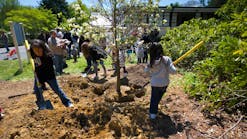During the second week of September 2017, it was evident that a hurricane was coming toward Florida.
I happened to live in Sarasota, Fla., at the time and was a newspaper reporter for a weekly publication covering the barrier island of Longboat Key. As part of my job, my editor asked me to stake out the local Publix and talk to customers as they loaded up their cars with their hurricane necessities.
Before being shooed away by management for having my camera around my neck (you never know when a good photo opp will come about!), I noticed that the water shelves were nearly empty.
I froze for a second and decided that I should probably grab two of the remaining cases for myself and my roommates. The three of us, all Florida transplants from the Midwest, had grown up with tornado drills as our most severe weather practice.
Hurricanes were a whole new ball game, and we weren’t really sure what to expect.
It hadn’t really dawned on me until that moment in Publix that if the hurricane hit Florida as hard as the National Oceanic and Atmospheric Administration (NOAA) was predicting, we potentially might not have a water source for days or longer. The average person uses 80 to 100 gallons of water a day.
What would without water look like? No shower. No flushing the toilet. And eventually, the water bottles would run out.
According to the Imagine a Day Without Water website, the average person can last almost a month without food. But without water? Just a week.
I had never had to think about what would happen without access to water, but unfortunately a lot of people do.
When Hurricane Irma hit Florida as a Category 3 storm, it spared Sarasota other than some power outages and downed trees. But other places weren’t so lucky.
Just two weeks after Hurricane Irma hit the U.S. Virgin Islands and then knocked Puerto Rico as a Category 5 storm, Hurricane Maria descended on the islands again. According to FEMA, the Federal Emergency Management Agency, Puerto Rico’s water systems were inoperable after Maria. Within 30 days, water service went from 20 to 60% operational and jumped to 91% operational in 60 days. It took a year before water systems were operating at 99.5%.
According to National Geographic, because there was no power throughout Puerto Rico, water was cut off for a lot of the population. With limited communication to the island, and FEMA working on disaster relief efforts from Hurricane Irma, what resulted was “the longest major power outage in U.S. history, and many communities on the island were left without running water for months. Toilets couldn’t flush, there was no water for showers, baths or washing clothes. People had to rely on bottled water, but supplies were limited,” National Geographic reported.
In the Virgin Islands, according to FEMA, the U.S. Environmental Protection Agency worked with the Virgin Islands Department of Planning and Natural Resources to sample school drinking water before reopening.
I got to go home to an apartment that had electricity and running water, but thousands, if not millions, of people did not. These are only two examples of communities where natural disasters have left water issues.
Water for People is working on its Everyone Forever initiative that aims to bring clean and safe water to everyone. According to the organization’s website, 2.1 billion people around the world do not have access to safe water, and 4.5 billion people don’t have access to proper sanitation.
Just having to think about not having water for day made me realize how much I really take it for granted. Thankfully, days like today exist, so that more people realize how precious water is. I encourage you to visit imagineadaywithoutwater.org to learn more.
Water is more than a necessity. As the Imagine a Day Without Water website states, hospitals would have to close, firefighters couldn’t stop fires and farmers couldn’t water their crops. Forget laundry or showering.
So now knowing all of this, I have to ask – what would your day look like without water?
As a newcomer to the water industry, I’d love to hear your thoughts. I can be reached at [email protected].
Read more about water scarcity:






